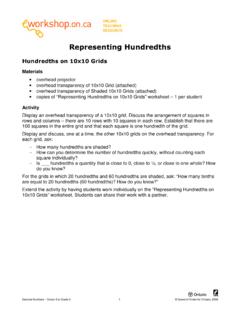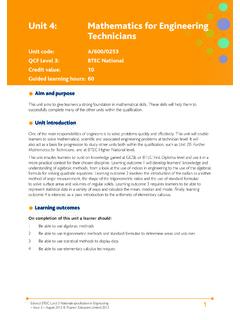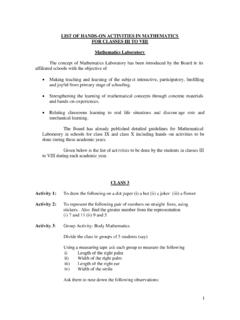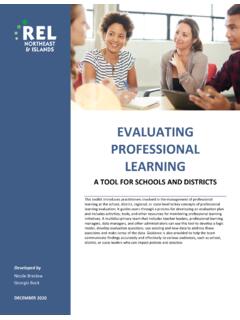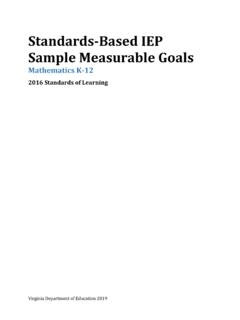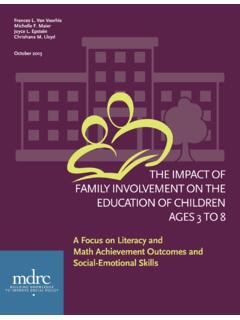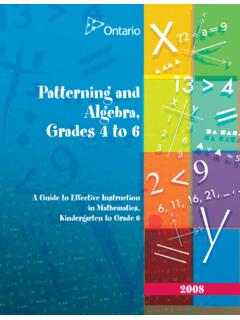Transcription of Measurement, Grades 4 to 6 - Eworkshop - L'Atelier
1 measurement , Grades 4 to 6A Guide to Effective Instructionin mathematics ,Kindergarten to grade 62008 measurement , Grades 4 to 6A Guide to Effective Instructionin mathematics ,Kindergarten to grade 6 Every effort has been made in this publication to identify mathematics resources and tools( , manipulatives) in generic terms. In cases where a particular product is used by teachersin schools across Ontario, that product is identified by its trade name, in the interests ofclarity. Reference to particular products in no way implies an endorsement of those productsby the Ministry of Education. CONTENTSI ntroduction5 The Pleasure of Mathematical Surprise and 5 Working Towards Equitable Outcomes for Diverse 6 Accommodations and 7 The Mathematical 9 Addressing the Needs of Junior 11 learning About measurement in the Junior 13 The Big Ideas of Measurement15 About Big 15 Big Ideas and Tiered 17 The Big Ideas of measurement in Grades 4 to 18 Attributes, Units, and measurement 21 Example: A Cubic 22 Method 1: Understanding the Cubic 23 Method 2: Extending the 27 measurement 31 Example: Developing Formulas From Student 31 Method 1: Understanding measurement 32 Method 2: Exploring measurement 36 References40 learning Activities41 Introduction to the learning 43 grade 4 learning Activities45 The First Decade of My Life(Attributes, Units, and measurement Sense).
2 45 Designing a Kindergarten Play Enclosure( measurement Relationships).. 553 grade 5 learning Activities67 Weather or (Attributes, Units, and measurement Sense) .. 67 Hiking the Bruce Trail( measurement Relationships).. 89 grade 6 learning Activities99 measurement at the Track Meet(Attributes, Units, and measurement Sense).. 99 Packaging the Chocolongo Bar( measurement Relationships).. 109 Glossary121 measurement , Grades 4 to 648 kg5 km350 g5km16 cmcm6 c6 cm220 C100 mLggINTRODUCTIONM easurement, Grades 4 to 6is a practical guide that teachers will find useful in helping studentsto achieve the curriculum expectations outlined for Grades 4 to 6 in the measurement strand ofThe Ontario Curriculum, Grades 1 8: mathematics , 2005. This guide provides teachers withpractical applications of the principles and theories that are elaborated in A Guide to EffectiveInstruction in mathematics , Kindergarten to grade 6, first part of the guide provides a detailed discussion of the two big ideas , or majormathematical themes, in measurement , and provides a discussion of mathematical modelsand instructional strategies that have proved effective in helping students understand themathematical concepts related to each big idea.
3 The guide emphasizes the importance offocusing on the big ideas in mathematical instruction to achieve the goal of helping studentsgain a deeper understanding of mathematical concepts. At the end of the first part of theguide is a list of references second part of the guide provides sample learning activities, for Grades 4, 5, and 6,that illustrate how a learning activity can be designed to: focus on an important curriculum topic; involve students in applying the seven mathematical processes described in the mathematics curriculum document; develop understanding of the big ideas in the end of the second part of the guide is a glossary that includes mathematical andother terms that are used in the Pleasure of Mathematical Surprise and InsightYoung children enter school mathematically curious, imaginative, and capable.
4 They haveto learn to be otherwise (Papert, 1980). The aim of this resource is to help consolidate andextend junior students mathematical capacity and their potential for mathematical growthby providing ideas and classroom activities that draw their attention to relationships embeddedin the big ideas of the measurement strand in the Ontario mathematics curriculum andthat offer them opportunities to experience the pleasure of mathematical surprise and insight(Gadanidis, 2004).5 The teaching of mathematics around big ideas offers students opportunities to develop a sophisticated understanding of mathematics concepts and processes, and helps them to maintain their interest in and excitement about doing and learning activities in this resource incorporate the ideas and practice of classroom teachers. The activities have been field-tested in Ontario classrooms, and feedback from practisingteachers has been used to create the final Towards Equitable Outcomes for Diverse StudentsAll students, whatever their socio-economic, ethnocultural, or linguistic background, musthave opportunities to learn and to grow, both cognitively and socially.
5 When students canmake personal connections to their learning , and when they feel secure in their learningenvironment, their true capacity will be realized in their achievement. A commitment toequity and inclusive instruction in Ontario classrooms is therefore critical to enabling allstudents to succeed in school and, consequently, to become productive and contributingmembers of create effective conditions for learning , teachers must take care to avoid all forms of biasand stereotyping in resources and learning activities, which can quickly alienate students andlimit their learning . Teachers should be aware of the need to provide a variety of experiencesand to encourage multiple perspectives, so that the diversity of the class is recognized and allstudents feel respected and valued. learning activities and resources for teaching mathematicsshould be inclusive, providing examples and illustrations and using approaches that recognizethe range of experiences of students with diverse backgrounds, knowledge, skills, interests, andlearning following are some strategies for creating a learning environment that acknowledges andvalues the diversity of students and enables them to participate fully in the learning experience: providing mathematics problems with situations and contexts that are meaningful to allstudents ( , problems that reflect students interests, home-life experiences, and culturalbackgrounds and that arouse their curiosity and spirit of enquiry); using mathematics examples drawn from diverse cultures, including those of Aboriginalpeoples.
6 Using children s literature that reflects various cultures and customs as a source of mathematical examples and situations; understanding and acknowledging customs and adjusting teaching strategies as example, a student may come from a culture in which it is considered inappropriate for a child to ask for help, express opinions openly, or make direct eye contact with an adult; considering the appropriateness of references to holidays, celebrations, and traditions; providing clarification if the context of a learning activity is unfamiliar to students ( , describing or showing a food item that may be new to some students); measurement , Grades 4 to 66 evaluating the content of mathematics textbooks, children s literature, and supplementarymaterials for cultural or gender bias; designing learning and assessment activities that allow students with various learningstyles ( , auditory, visual, tactile/kinaesthetic) to participate meaningfully; providing opportunities for students to work both independently and interdependentlywith others; providing opportunities for students to communicate orally and in writing in their home language ( , pairing English language learners with a first-language peer who also speaks English).
7 Using diagrams, pictures, manipulatives, sounds, and gestures to clarify mathematicalvocabulary that may be new to English language a full discussion of equity and diversity in the classroom, as well as a detailed checklistfor providing inclusive mathematics instruction, see pages 34 40 in Volume 1 of A Guide to Effective Instruction in mathematics , Kindergarten to grade 6, and ModificationsThe learning activities in this document have been designed for students with a range oflearning needs. Instructional and assessment tasks are open-ended, allowing most students to participate fully in learning experiences. In some cases, individual students may require accommodationsand/or modifications, in accordancewith their Individual Education Plan (IEP), to support their participationin learning ACCOMMODATIONSS tudents may require accommodations, including special strategies, support,and/or equipment to allow them to participate in learning are three types of accommodations: Instructional accommodationsare adjustments in teaching strategies,including styles of presentation, methods of organization, or the useof technology or multimedia.
8 Environmental accommodationsare supports or changes that the studentmay require in the physical environment of the classroom and/or theschool, such as preferential seating or special lighting. Assessment accommodationsare adjustments in assessment activitiesand methods that enable the student to demonstrate learning , such asallowing additional time to complete tasks or permitting oral responsesto test of the ways in which teachers can provide accommodations withrespect to mathematics learning activities are listed in the chart on page term accommodationsis used to refer to the specialteaching and assessmentstrategies, human supports,and/or individualized equipment required toenable a student to learnand to demonstrate do not alterthe provincial curriculumexpectations for the grade . Modificationsare changesmade in the age-appropriategrade-level expectations for asubject.
9 In order to meeta student s learning changes may involvedeveloping expectations thatreflect knowledge and skillsrequired in the curriculum fora different grade level and/orincreasing or decreasing thenumber and/or complexity of the regular grade -levelcurriculum expectations. (Ontario Ministry ofEducation, 2004, pp. 25 26) measurement , Grades 4 to 6 Environmental Accommodations Provide an alternative work space. Seat students strategically ( , near the front of the room; close to the teacher in group settings;with a classmate who can help them). Reduce visual distractions. Minimize background noise. Provide a quiet setting. Provide headphones to reduce audio distractions. Provide special lighting. Provide assistive devices or adaptive equipment. Assessment Accommodations Have students demonstrate understanding using concrete materials, computer software, or orallyrather than in written form.
10 Have students record oral responses on audiotape. Have students responses on written tasks recorded by a scribe. Provide assistive technology, such as speech-to-text software. Provide an alternative setting. Provide assistive devices or adaptive equipment. Provide augmentative and alternative communications systems. Format tests so that they are easy to understand ( , use large-size font; an uncluttered layout; spatial cues, such as arrows; colour cues). Provide access to computers. Provide access to calculators and/or addition and multiplication grids. Provide visual cues ( , posters). Provide extra time to complete problems or tasks or answer questions. Reduce the number of tasks used to assess a concept or Accommodations Vary instructional strategies, using different manipulatives, examples, and visuals ( , concrete materials,pictures, diagrams) as necessary to aid understanding.







